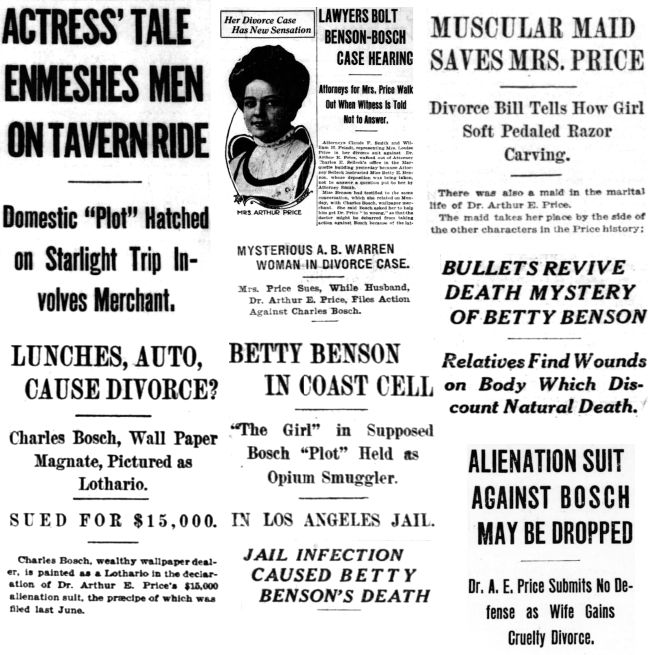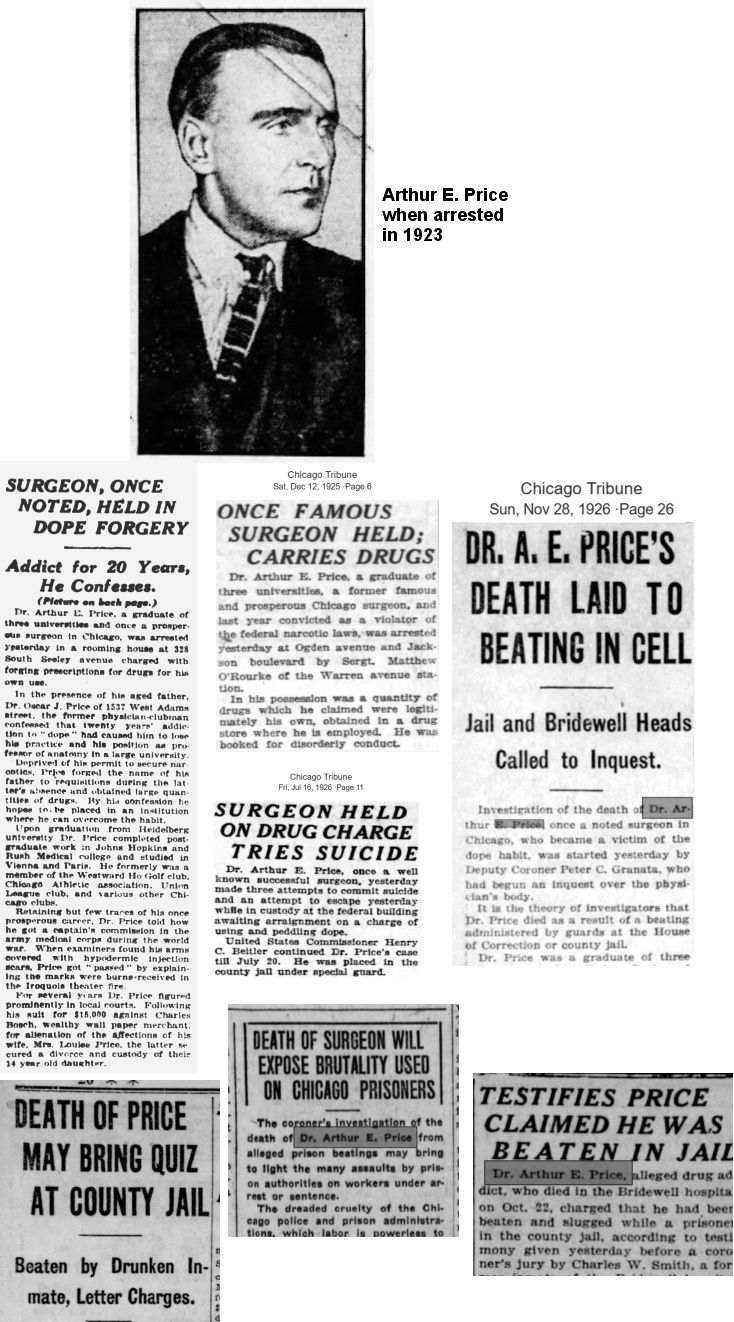|
Seventeen-year-old Viola Plowden Stevens (1886–1949), who went by Plowden Stevens, was born as Mary Stewart, birth parents not
known. In December 1888, as a toddler, she was adopted by Viola Adele Tarbox Tarbox (1854–1915) and the late Plowdon▼1
J. Stevens (1832–1896). Her mother had remarried in 1897 to Chicago organist and vocal
teacher, William Dresden (1853–1924). Nine months
before the Iroquois Theater fire the Dresdens had left Chicago and
moved into their newly remodeled mansion, "Castle Rest," at 121 N. St. Joseph Avenue in Niles, Michigan.▼2
Plowden's escort, twenty-eight-year-old Dr. Arthur Edgar Price (1875–1926) was an
unmarried surgeon from Chicago, living with his parents, Dr. Oscar and Anna Wilder Price
In the years after the fire
A year after their escape from the Iroquois Theater, the parents of Plowden
and Arthur Price put out a different kind of fire when newspapers noted that schoolgirl Plowden's new beau was twelve
years her senior. After emphatic denials to the press about a marital engagement,
nothing more was published to suggest they were allowed within miles of one another. Plowden went off
to Mount Vernon Seminary in Washington, D.C. far, far away, and lived the life of wealthy
comfort she'd been born into. In 1908 she married John Grier and they spent most of their lives in Detroit where John
worked for General Box Corporation. They had one child (see pic above) and retired to Clearwater, Florida.
Price spent the next twenty years going in the opposite direction.
It was a sad tale that opened with promise. He had followed his father — surgeon Dr. Oscar J. Price of Chicago — into
medicine and graduated from three universities: John Hopkins, Heidelberg University and Rush
Medical College. In 1907 he was a professor of surgery at the College of Physicians
and Surgeons in Chicago (University of Illinois College of Medicine) when he married Louise Higman and their daughter was born in 1909.
Things looked good until 1915 Price and his wife appeared in divorce court, accusing one another of infidelity.
The bizarre case turned into a shouting match for nearly two years of newspaper headlines,
with a provocative storyline Roger Stone would have milked. It included descriptions of
doctor Price's drunken
attacks on his wife, involving knives, razors, choking, and multiple disarmaments by a six-foot-tall
maid, and a wallpaper merchant, topped off with a part-time actress in a rowdy car ride whose new husband was shot on
their honeymoon, after which she was imprisoned for opium smuggling, died of pneumonia and
infection wounds that looked like bullet wounds.

|
 |
Louise got her divorce and when World War I broke out, Arthur enlisted and served as a
captain, though passing the medical exam required deception. Keep reading.
A 1918 newspaper story included an odd
tidbit. Arthur was then operating a first aid clinic for workers, his days as
a prestigious surgeon and college professor behind him.
In the 1920 U.S. Census Arthur claimed to be widowed (a common vanity fib told by divorcees in the early 1900s). The more
curious part of his status, however, was that he lived with a housekeeper named Mary
Stewart, Plowden Stevens birth name, the same age as Plowden. Who was happy as a
clam with John Grier in Detroit. Just a coincidence but an odd one. That
year Price was also cited as one of a long list of Chicago physicians charged with issuing
prescriptions for alcohol — a no-no during Prohibition.
In December 1923 Arthur was arrested for forging his fathers name on drug prescriptions and confessed to a twenty-year addiction to narcotics (which means
his drug use started in 1906, a year before his marriage. His wife and daughter never knew him as a fully sober man.
In his confession he volunteered that during the medical exam prior to his induction into
the military he lied and attributed his track marks to scars from the Iroquois Theater fire.

Additional arrests followed in 1926, along with multiple suicide attempts and imprisonment.
He was finally beaten to death while in prison, by guards or prisoners.
His father died three years later.
|
Discrepancies and addendum
1. Spelled Plowden and Plowdon, the latter used on his gravestone.
2. In 1899 a flimflam man who called himself Dr. Arthur C. Probert, among other
names, had swept into
Niles and purchased what was known as the Colby property on the west side of town. Located on
St. Joseph Avenue, the five-acre parcel consisted of a Victorian mansion and barn overlooking the St.
Joseph river. The home was built by merchant and banker Gilbert A. Colby (c1814–1894).
It would be known as the "Colby mansion" for decades prior to Probert's arrival, sometimes rented or sold to other owners but so far as
Niles was concerned, it was the Colby mansion. (Colby was a prominent Niles citizen
who helped spearhead the renaming of Division St. to Joseph Avenue in 1865.) Despite Probert's grand
predictions, St. Luke's Hospital / Niles Sanitarium never housed a patient. Instead
Probert turned it into a short-lived but notorious medical diploma mill. When his scams drew attention from postal
inspectors and the Michigan state legislature began regulating the issuance of medical
diplomas, he lit out for Colorado and the property became vacant once again. William and Viola Dresden came along
at the right time. Viola had inherited 80% of her late husband Plowden Stevens' $290,000 estate
(inflation adj. $10.7 million) so could afford the $10,000 purchase price and substantial
rehab cost. (The Dresdens also purchased the adjacent property of Eugene C.
Dana, giving them the corner at St. Joseph Avenue and Grant St.)
As described in this 1903 newspaper article, remodeling and redecorating its twenty-six
rooms, sea wall, grounds and barn took the better part of a year. The Dresden's
did not treat Castle Rest as a summer home but became active in the Niles community,
donating time and money to numerous organizations, clubs and city projects from the humane
society to the Episcopal Church. From all accounts Dell Dresden was a whirlwind of
activity, a force to be reckoned with.
At William Dresden's death in 1924, Viola and her
daughter sold Castle Rest to the wealthy Mr. & Mrs. F. J. Plym who gave the property and $100,000 to the city to create a community hospital.
Its open house ceremony was held October 30, 1926 and its first patient arrived two weeks
later. In 1992 the property became the site of Lakeland Hospital and the marble
fireplace from Castle Rest was reportedly installed in the lobby.
|
